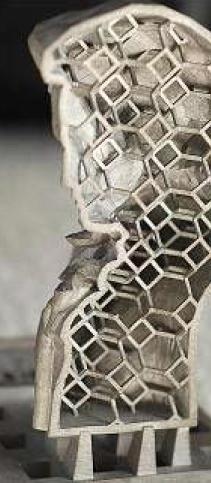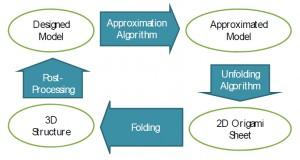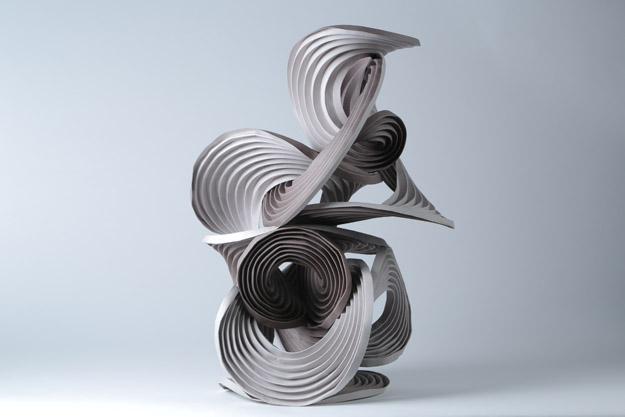Japanese origami, the art of paper folding, began some time after Buddhist monks first carried paper to Japan during the 6th century. Initially, it was used for religious ceremonial purposes, and that was mostly due to the high price of paper at the time. It’s said that Samurai warriors once exchanged gifts adorned with noshi, good luck tokens made of folded strips of paper.
The modern interest in origami can be traced to the work of Akira Yoshizawa, the artist who created a notation to indicate how to fold origami models. Called the Yoshizawa-Randlett system, it served as the basis for origami societies in Britain, the USA, and Spain. For their part, the Chinese say Japanese origami is a only a historical derivative of Chinese paper folding techniques.
Now researchers have created what they call Assembled Additive Manufacturing, and it’s basically a hybrid process for fabricating objects which was inspired by the delicate and intricate constructs made with the ancient art of origami.
 The authors of a paper on the subject, Dongping Deng and Dr. Yong Chen, of the Daniel J. Epstein Department of Industrial and Systems Engineering at the University of Southern California, say it’s a lightning fast AM process creating prototype models with thin-shell shapes.
The authors of a paper on the subject, Dongping Deng and Dr. Yong Chen, of the Daniel J. Epstein Department of Industrial and Systems Engineering at the University of Southern California, say it’s a lightning fast AM process creating prototype models with thin-shell shapes.
“We developed various approaches, and Origami was one of the topics identified,” Chen says. “We began to investigate the origami idea to improve the building speed of additive manufacturing. The test cases were designed to demonstrate the capability of the developed method. How to fold the designed sheet accurately is one of challenges we experienced.”
Chen was a senior R&D engineer at 3D Systems for five years before joining the faculty at USC, and he says it was working closely with customers in the private sector that provided a major influence on his current research at USC.
It begins with the analysis of a digital model to determine geometries which can be fabricated using layer-based — and origami-based — approaches.
 The thin-shell model which results from the origami-based approach is unfolded into a 2D sheet, and once the fabrication and folding of the 2D sheet is complete, a post-processing technique is developed before the final prototype is fabricated using the 3D printed, layer-based fabrication process.
The thin-shell model which results from the origami-based approach is unfolded into a 2D sheet, and once the fabrication and folding of the 2D sheet is complete, a post-processing technique is developed before the final prototype is fabricated using the 3D printed, layer-based fabrication process.
Chen and the research team say objects with thin-shell structures are commonly used in various products from food containers to storage boxes, and the lightweight and less material-intensive results will be widely used in the engineering systems of the future to satisfy sustainability requirements.
A general method based on offsetting polygonal models was presented to convert a solid object into a hollow one to reduce its weight.
The say the process works because their 3D texture-mapping method can capture complex internal structures to achieve both light weight and required strength.
 It all comes down to the fact that hollow objects with thin-shell structures are quite difficult to build using subtractive or deformation-based manufacturing processes like machining and injection molding. In those processes, tools have a hard time accessing the internal features needed, while layer-based additive manufacturing (AM) processes overcome those limitations by converting a 3D model into a set of 2D layers for final fabrication.
It all comes down to the fact that hollow objects with thin-shell structures are quite difficult to build using subtractive or deformation-based manufacturing processes like machining and injection molding. In those processes, tools have a hard time accessing the internal features needed, while layer-based additive manufacturing (AM) processes overcome those limitations by converting a 3D model into a set of 2D layers for final fabrication.
The scientists say experimental tests of the Assembled Additive Manufacturing (AAM) process have been performed to compare the fabrication speeds of the AAM and the layer-based AM processes, and those tests have found potential benefits of the AAM process in creating hollow objects by shortening the fabrication time and removing the need for printed supports. They say the next steps are developing a more general unfolding algorithm for a given CAD model, developing internal and external actuation mechanisms for better control of self-folding and automatic folding, testing the AAM process in the micro-scale, and identifying novel applications for their method.
What ancient arts or sciences can you imagine with influence modern technology the most? Have you ever worked on a technology project that took ancient arts as inspiration? Let us know about your experiences in the Origami Will Influence Additive Manufacturing forum thread on 3DPB.com.
Subscribe to Our Email Newsletter
Stay up-to-date on all the latest news from the 3D printing industry and receive information and offers from third party vendors.
You May Also Like
3D Printing Webinar and Event Roundup: May 5, 2024
We’ve got a busy week of 3D printing events ahead of us, in Texas, Florida, Washington, D.C., Shanghai, and more. Webinar offerings will cover medical models, PolyJet 3D printing, additive...
High Stakes, High Speed: KVG Acquires 15 Nexa3D HSE 3D Printers to Boost Military Tech
As 3D printing increasingly intersects with defense and military logistics, a new partnership between Nexa3D and mission support logistics firm KVG stresses the growing importance of this technology in strategic...
Construction 3D Printing CEO Reflects on Being Female in Construction
Natalie Wadley, CEO of ChangeMaker3D, could hear the words of her daughter sitting next to her resounding in her head. “Mum, MUM, you’ve won!” Wadley had just won the prestigious...
3D Printing News Briefs, February 17, 2024: Shot Blasting, Service Bureaus, & More
In today’s 3D Printing News Briefs, we’re starting out with post-processing, as SKZ Würzburg is using a shot blast system from AM Solutions for its research. Moving on to business,...
































